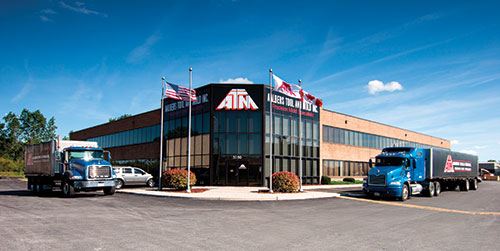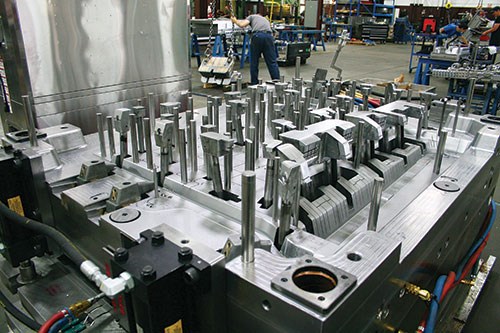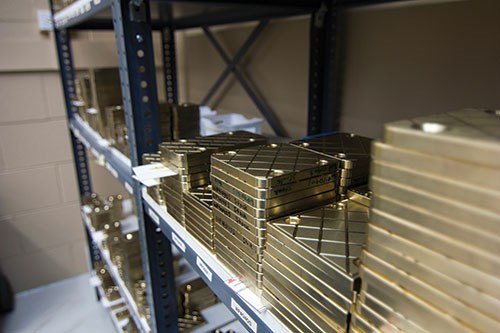The Value of Insourcing and Standardizing Component Work
To become more competitive, this mold manufacturer established a components division to build a growing selection of its own mold components.
In a time when everyone seems to be trying to look at outsourcing as a way to stay competitive, Oldcastle, Ontario-based Aalbers Tool & Mold has gone against the grain, and it has paid off.
If you walk through this company’s crib, you will see the usual rows upon rows of components waiting to be installed into jobs. Screws, springs, pins and bushings line the shelves. Look a little closer, however, and you will start to notice some components that similar manufacturers don’t typically keep in stock. That’s because Aalbers has a components division that builds a growing selection of its own components.
Aalbers Tool & Mold was founded in 1982 by CEO Gary Aalbers to design and manufacture large plastic injection molds for the automotive and consumer goods industries. (The company also has expertise in fabric insert tooling.) Traditionally, these molds are made from raw blocks of steel machined to shape, combined with about 80 percent purchased components (screws, pins bushings, etc.) and 20 percent components custom-made for a particular job.
“A few years ago we looked at all the custom components we were making for each job, and we soon realized that we needed more standardization,” explains Toni Hansen, president. “For instance, we noticed that designers put in wear plates based on the size of the slide. The size of the wear plate differed from designer to designer. Even screw sizes and placement would vary. These custom plates were expensive and time-consuming to manufacture, so we set out to standardize them.”
In developing standards, the Aalbers team decided on the proper screw spacing and size, as well as proper clearance and critical dimensions. Once the team developed the standards, it could then make the components in advance and stock them in various sizes.
Reaping the Benefits
Aalbers Tool & Mold has experienced numerous benefits from the standardization and in-house manufacturing of its mold components, including:
Fewer opportunities for error. “Our designers are aware of the sizes in stock, and they use those sizes whenever possible,” notes Engineering Manager Don Stockwell. “Each plate is part of our CAD library in TopSolid. The models contain everything: wear plates, pockets, screws and screw holes—all finished. In addition, we keep all manufacturing information on file for each size. This reuse of information saves us time with each design and also reduces opportunity for error.”
Decreased manufacturing time. “In the past, a custom component would take a fair amount of time to produce,” Hansen points out. “We now manufacture them in batches using an automated process. It takes less time and has reduced the chance of errors. One custom component could take 30 minutes to produce, but now we can produce 10 of them in the same amount of time—a 90-percent savings in labor.”
Reduced lead times. As a result, lead times at Aalbers have been significantly impacted. “We can produce molds faster because no one is waiting for a custom part to be manufactured. We always have our own components in stock,” Hansen says.
Aalbers still purchases a few standard components from other suppliers, but if there is ever a problem with lead time on these orders, its component division can quickly manufacture the part to order.
Improved customer service. Standardization has truly benefited Aalbers customers, according to Doug Thompson, who is in the company’s technical sales department. “If a part gets damaged or worn, we can quickly take one off the shelf and send it along to the customer. No more waiting for a custom part to be manufactured,” he says. “If our customer isn’t local, he doesn’t have to look for a local tool shop to repair the tool or pay expensive shipping costs; we can ship him the part and he can be back up and running in no time.”
Hidden cost savings. Other cost savings are harder to measure but are very evident to Aalbers. For example, parametric CAD systems enable designers to design parts to any size they desire, but this flexibility can also be a big problem, according to Hansen. “Not all designers have the same experience, and all are prone to typing in the occasional wrong value. The more we standardize, the more we reduce these potential errors.”
In addition to the increased potential for actual engineering errors, allowing a designer to pick any size he wants can have drastic cost implications that may not be caught until it’s too late.
“Designers are not purchasers, and purchasers are not designers,” Hansen says. “A designer may not know that the size he picked is much more expensive than the next size up or down. A purchaser has no way of knowing if the designer considered a cheaper size. This type of situation occurs all the time, so by taking control of standards, we can lessen the chance of this happening.”
Continuous improvement. Standardization also has helped foster a culture of continuous improvement at Aalbers. The company now holds monthly meetings to discuss ideas for improving component design. Team leaders from design, manufacturing and sales meet to ensure everyone is looking at improvements from all aspects.
The goal is simple, Hansen says. “It has to improve time and quality, and help lower costs. We still purchase some components from suppliers, but what started with a few components has now grown to a large library of our own standard components.
“We are moldmakers not just mold assemblers. We know how each part functions within our tools. We know what works. Having our own components manufacturing division in house allows us to think outside the box. When in the past we may have just purchased a standard component, today we consider each component’s purpose and design. We have added many improvements to our own components that are not offered by industry catalogs.”
Component standardization also enables Aalbers to better judge an item’s long-term durability. “Previously, when parts were designed one up, we had zero repeatability with no control over the long-term quality of our products,” Hansen explains. “Now if we see a problem arise, we can fix it in thevstandards and know that this fix will carry on to each new build, improving our overall quality.”
Opportunity Keeps on Knocking
CEO Gary Aalbers says it’s not uncommon for his company to receive requests from other mold manufacturers wishing to purchase components. “With our recent expansion—coinciding with our 30-year anniversary—we now have over 100,000 square feet of manufacturing space, and we are currently investigating the potential of offering a line of specialty components from our patent-pending designs."
Related Content
How to Eliminate Chatter
Here are techniques commonly used to combat chatter and guidelines to establish a foundation for optimizing the moldmaking process.
Read MoreThe Ins and Outs of Hot Runner Temperature Control
A training checklist that explains the why and how of proper hot runner temperature control and system management.
Read MoreMaintaining a Wire EDM Machine
To achieve the ultimate capability and level of productivity from your wire EDM on a consistent, repeatable and reliable basis, regular maintenance is a required task.
Read MoreRead Next
Testing Engineered Options for Mold Alignment
Performance data on alignment components helps select the best treatment, improve the design and chart more precise application recommendations.
Read MoreHow to Use Strategic Planning Tools, Data to Manage the Human Side of Business
Q&A with Marion Wells, MMT EAB member and founder of Human Asset Management.
Read MoreHow to Use Continuing Education to Remain Competitive in Moldmaking
Continued training helps moldmakers make tooling decisions and properly use the latest cutting tool to efficiently machine high-quality molds.
Read More























